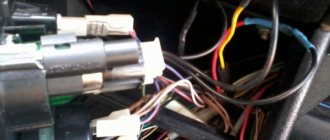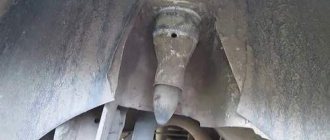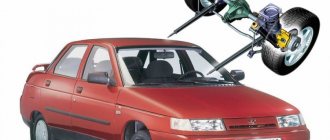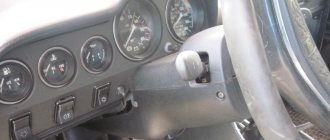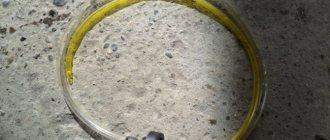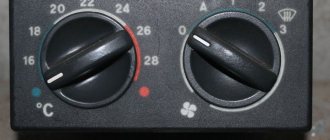The brake system fault indicator is on
Most often, the reason is trivial - like a low level of brake fluid in the reservoir or excessive wear of the brake pads equipped with the corresponding sensors. Another simple reason could be... the parking brake is on (it happens that the limit switch is simply faulty). However, brake fluid leaks can also be the cause of a decrease in the level - they must be urgently identified and eliminated.
The device of the brake system of the VAZ 2107
RTS structurally consists of:
- Brake master cylinder (MBC) (item 4).
- Vacuum brake booster (VUT) (item 3).
- Brake pedal assembly (item 24).
- Containers for brake fluid equipped with a level sensor (item 8).
- Brake mechanisms (disc type) of the front wheel pair (items 1, 2, 6).
- Braking mechanisms (drum type) of the rear wheel pair (pos. 15, 16).
- Brake fluid pressure regulator in the rear brake circuit (item 12).
- Brake line pipelines (items 5, 7, 11).
STS structurally consists of:
- Adjustment unit (pos. 18, 20)
- Parking brake lever (item 10).
- A cable system, including front (pos. 21) and rear (pos. 17) cables.
- The lever for actuating the brake pads (item 14).
- Guide (pos. 19).
- The drive of the STS “seven” is mechanical, cable type.
Parking brake ineffective
Have you tightened the lever, but the car still tries to roll downhill? In the simplest cases, the parking brake just needs to be adjusted normally. In addition, oiliness of the brake pads can affect it. It happens that the cables are jammed in the sheaths. Possible causes include oily discs or drums. Completely worn out pads may be to blame. And if the parking brake does not release the car, then most likely the pads are frozen or rusted to the brake drums.
Brake system VAZ 2107
The braking system on the “seven” ensures safety when driving. And if the engine is needed for movement, then the brakes are needed for braking. At the same time, it is very important that braking is also safe - for this purpose, the VAZ 2107 was equipped with brake mechanisms that use the friction forces of various materials. Why was this necessary? This was the only way in the 1970s and 1980s to quickly and safely stop a car speeding at high speed.
Brake system elements
The brake system of the “seven” consists of two main components:
- service brake;
- parking brake.
The main task of the service brake is to quickly reduce the speed of the machine until it comes to a complete stop. Accordingly, the service brake is used in almost all cases of driving a car: in the city at traffic lights and parking lots, when the speed of traffic decreases, when disembarking passengers, etc.
The service brake is assembled from two elements:
- Braking mechanisms are various parts and assemblies that have a stopping effect on the wheels, as a result of which braking occurs.
- The drive system is a series of elements that the driver controls to apply the brakes.
The “seven” uses a dual-circuit braking system: disc brakes are installed on the front axle, and drum brakes are installed on the rear axle.
The purpose of the parking brake is to completely lock the wheels on the axle. Since the VAZ 2107 is a rear-wheel drive car, in this case the wheels of the rear axle are blocked. Locking is necessary when the car is parked to prevent the wheels from moving arbitrarily.
The parking brake has a separate drive that is in no way connected to the drive part of the service brake.
The handbrake is the element of the parking brake visible to the driver.
How does it all work
The principle of operation of the VAZ 2107 brake system can be briefly described as follows:
- The driver, while driving along the highway, decides to slow down or stop.
- To do this, he presses the brake pedal with his foot.
- This force immediately falls on the valve mechanism of the amplifier.
- The valve slightly opens the supply of atmospheric pressure to the membrane.
- The membrane acts on the rod through vibration.
- Next, the rod itself exerts pressure on the piston element of the master cylinder.
- The brake fluid, in turn, begins to move the pistons of the working cylinders under pressure.
- Due to pressure, the cylinders are expanded or pressed (depending on whether disc or drum brakes are on a given vehicle axle). The mechanisms begin to rub the pads and discs (or drums), due to which the movement speed is reset.
The system includes more than 30 elements and assemblies, each of which performs its own function during braking
Features of braking on the VAZ 2107
Despite the fact that the VAZ 2107 is far from the most modern and safe car, the designers made sure that the brakes worked flawlessly in emergency situations. Just because the system on the “seven” is dual-circuit (that is, the service brake is divided into two parts), it is possible to brake even one part of the circuit if the other is depressurized.
Therefore, if air gets into one of the circuits, then only that needs to be serviced - the second circuit is working properly and does not need additional maintenance or bleeding.
Video: the brakes on the “Seven” failed
Brake overheating
This type of malfunction is usually identified by the appearance of a burning smell. This is usually accompanied by an increased pedal travel, which begins to feel weak, as well as an increased braking distance. The cause of overheating can be either excessively active driving with constant braking, or simple forgetfulness, that is, the parking brake is too tight.
Additionally, possible culprits include seized cylinders and calipers.
Basic faults
The brake system itself is quite simple, but some of its elements require special attention. Main types of faults:
- The brake fluid leaks, resulting in a drop in pressure in the system. If a preliminary inspection does not find a leak, it is necessary to check the brake master cylinder. We bend the noise-insulating mat located under the brake pedal and inspect for streaks in the area of the rubber seal of the master cylinder. The presence of drips will indicate that the cause has been found and requires disassembling the cylinder and then replacing the cuff. If there is a vacuum booster, the brake master cylinder must be removed and inspected.
- When you release the brake pedal, the car drives sluggishly. Reason: the rear or front pads are jammed. Seized pads are identified by checking the heat of the corresponding wheel. We touch each disk - the hottest one will be jammed. In the case when these are the front wheels, you can, after removing the wheel, move the brake cylinder. If this fails, you will have to replace it with a new one. In the case of rear pads, the brake wheel cylinder will need to be replaced.
- When you press the pedal, braking does not occur, but it does when you press it several times in a row. This may indicate the presence of air in the system. The solution to the problem is to bleed the brakes to remove air.
- Problem with the handbrake. Most often this problem occurs in winter. It manifests itself in the fact that after a long period of parking, when the handbrake is released, the wheels remain locked. The reason is that the parking brake cable is frozen. During its operation, moisture gets there and freezes in winter. If the casing is severely damaged, it will have to be replaced.
Brake master cylinder diagram
Vibration when braking
This is a fairly common malfunction that is associated solely with critical or uneven wear of the discs or drums, and the repair will consist of replacing them.
Car shifts to the side when braking
The malfunction is due to either a failure of the working (wheel) cylinder or wear of the pads. Replacing them (or repairing them) will solve the problem.
The VAZ 2107 brake pedal fails: the main reasons
The brake system must be sealed and free of air. If the pedal begins to fail, then, with a greater degree of probability, we can say that depressurization has occurred, that is, air has entered the system.
- rust formation on the pedal linkage;
- failure of the vacuum booster;
- unadjusted distance between the cylinder piston and the pedal itself;
- lack of fuel fluid in the system.
It is also important to remember that brake fluid is an aggressive substance that can destroy thin pipes and even lines. That is why it is important to use only high-quality TZ. Low-quality liquid can form cracks through which it then flows out safely. But the flip side of the coin is that when you press the brake pedal, air leaks through these cracks.
Noise when braking
High-frequency noise, squealing, and whistling can occur both during braking and, sometimes, during normal movement. The reason is the off-design mode of friction of the friction material on the working surface of the brake disc. Extreme wear on the brake pads and severe corrosion of the brake disc (often on the inside, “invisible” side) may be to blame. It happens that the brake pad lining has peeled off from the base. The list of possible causes continues with contamination of the pads, warping of the disc due to local overheating, improper fastening of the pads in the caliper, left pads or discs, etc.
Caliper device
Let's move on. The front axle mechanisms are disk ones, consisting of calipers with the main brake elements - pads, and brake discs.
A caliper is a body with cylinders made in it for the pistons. This model has two of them, one for each block. The support structure is shown in the figure.
The caliper pistons have the form of a glass, which is placed in their cylinders, but they can move along it. To prevent fluid leakage, the pistons are equipped with o-rings.
Pads are small metal plates onto which linings made of friction material are glued.
The brake disc is made of metal for better adhesion to the surface of the pads; its side surfaces are well processed so that there are no protrusions or shells on them.
The VAZ 2107 brakes work like this: the fluid moves into the caliper cylinders, where it begins to push out the pistons. They come out of the cylinders, pressing the pads against the disc.
When the brake pedal is released, one of the wheels slows down
The following reasons are suspected: jamming of the wheel cylinder piston, swelling of the brake cups, deformation of the brake pipe, jamming of the pads due to contamination of the guide, peeling of the brake pad lining of the drum brake. It happens that the tension spring of the drum brake shoes is weakened or broken, the parking brake is overtightened, or the cable is stuck in the sheath.
- Do you know which faults you can drive with and which ones you cannot? Take the test and check your driving skill level.
- To increase the life of your car, use additives from SUPROTEC. Original SUPROTEC products can be purchased at.
Parking brake malfunction
This defect is the most common when the car moves involuntarily even with the handbrake locked. This is due to wear on the pads, discs or drums, as well as stretching of the cable elements.
According to the requirements of the “List...”, a parked vehicle must ensure that the passenger car is stationary:
- on a slope of up to 16% at full load;
- on a 23% slope when equipped.
In the event that these requirements are not met, the vehicle can only be driven to a parking or repair site. Repair of the malfunction is ensured by adjusting the cable tension with a special nut or replacing worn parts.
The design of the VAZ 2107 brake system: main mechanisms
The 7's braking system contains many small parts. Each of them serves the sole purpose of protecting the driver and people in the cabin while braking or parking the car. The main mechanisms on which the quality and efficiency of braking depends are:
- master cylinder;
- amplifier;
- regulator;
- pads;
- disks;
- drums;
- pedal;
- highways.
Master cylinder
The master cylinder body works in direct connection with the amplifier. Structurally, this element is a cylindrical mechanism to which the brake fluid supply and return hoses are connected. Also, three pipelines leading to the wheels extend from the surface of the master cylinder.
Inside the master cylinder are piston mechanisms. It is the pistons that are pushed out under the pressure of the fluid and create braking.
The use of brake fluid in the VAZ 2107 system is explained simply: there is no need for complex drive units and the path of the fluid to the pads is simplified as much as possible.
Vacuum booster
When the driver presses the brakes, the initial boost goes directly to the booster device. The VAZ 2107 is equipped with a vacuum booster, which looks like a container with two chambers.
Between the chambers there is a very sensitive layer - a membrane. It is the initial force—pressing the pedal by the driver—that causes the membrane to vibrate and create a vacuum and pressurize the brake fluid in the reservoir.
The design of the amplifier also contains a valve mechanism, which performs the main function of the device: it opens and closes the cavities of the chambers, creating the necessary pressure in the system.
Brake force regulator
The pressure (or brake force) regulator is mounted on the rear wheel drive. Its main task is to evenly distribute brake fluid to the components and prevent the car from skidding. The regulator functions by reducing the existing fluid pressure.
The drive part of the regulator is connected to the rod, with one end of the cable fixed on the rear axle of the car, and the other directly on the body. As soon as the load on the rear axle increases, the body begins to change position relative to the axle (skid), so the control rod cable immediately puts pressure on the piston. This is how the braking forces and the course of the car are adjusted.
Brake pads
There are two types of pads for the VAZ 2107:
- for front axle wheels with disc brakes;
- for rear axle wheels with drum brakes.
The pads are made of high-strength steel; a friction lining is attached to the base of the frame. Modern pads for the “seven” can also be purchased in a ceramic version.
The pad is attached to the disc or drum using special hot-melt adhesive, since when braking, the surfaces of the mechanisms can heat up to a temperature of 300 degrees Celsius.
Front axle disc brakes
The principle of operation of disc brakes on the VAZ 2107 comes down to the fact that pads with special linings, when you press the brake pedal, fix the brake disc in one position - that is, they stop it. Disc brakes have a number of advantages when compared with drum brakes:
- braking efficiency is not reduced due to overheating;
- high resistance to braking on snow, ice and water;
- unpretentiousness in maintenance;
- large friction area.
The disc is made of cast iron, so it weighs quite a lot, although it is very durable. The pressure on the disc is exerted through the disc brake working cylinder.
Rear axle drum brakes
The operation of a drum brake is identical to that of a disc brake, the only difference being that the drum with pads is installed on the wheel hub. When you press the brake pedal, the pads clamp the rotating drum very tightly, which, in turn, stops the rear wheels. The piston of the drum brake wheel cylinder also functions by using brake fluid pressure.
